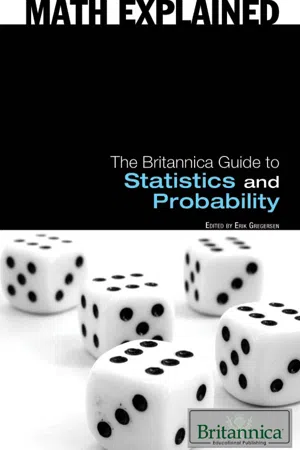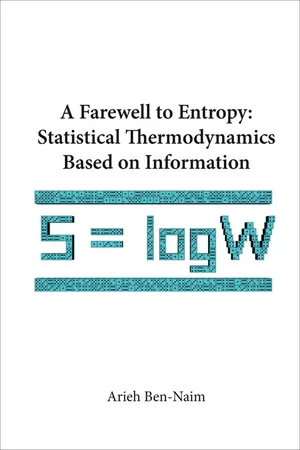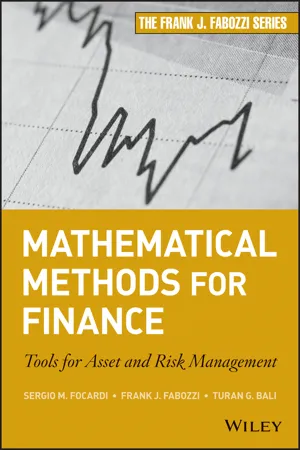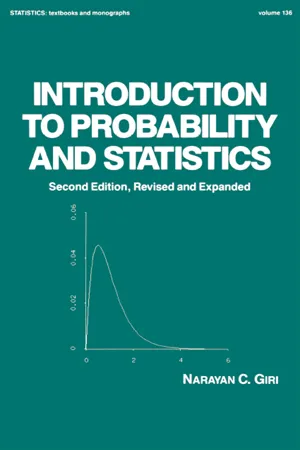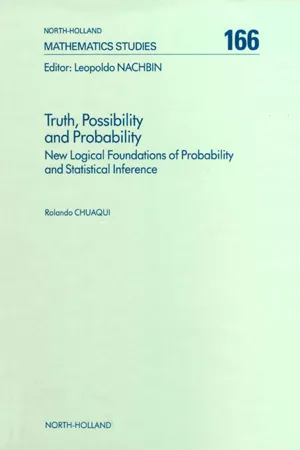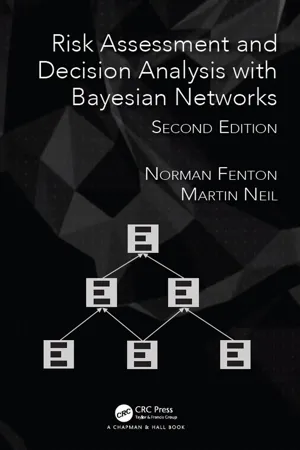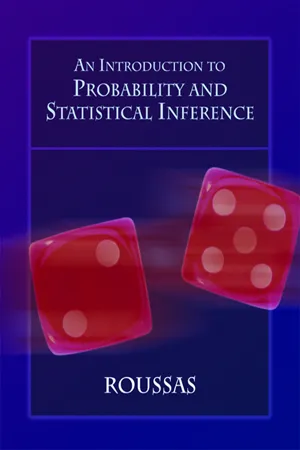Mathematics
Probability
Probability is a measure of the likelihood of a specific event occurring. It is expressed as a number between 0 and 1, where 0 indicates impossibility and 1 indicates certainty. In mathematics, probability theory is used to analyze random phenomena and make predictions based on the likelihood of different outcomes.
Written by Perlego with AI-assistance
Related key terms
10 Key excerpts on "Probability"
- eBook - ePub
Quantitative Techniques in Business, Management and Finance
A Case-Study Approach
- Umeshkumar Dubey, D P Kothari, G K Awari(Authors)
- 2016(Publication Date)
- Chapman and Hall/CRC(Publisher)
The development of the theory of Probability dates back to the seventeenth century. The Probability formulae and techniques were developed by Jacob Bernoulli (1713), De Moivre (1718) and Thomas Bayes (1764). Most of these were concerned with the application of the theory of permutations and combinations to the calculation of probabilities associated with various dice and card games.Probability means ‘a chance’. It can be defined as an expression of chance of occurrence of an event. Probability is used in making viable predictions, suitable decisions, convenient planning and operational policies. Thus, Probability is one of the significant contributors to the science of quantitative techniques.The degree of uncertainty can be measured numerically with the help of Probability. Probability theory is used to analyse data for decision making.- The insurance industry uses Probability to calculate premium rates.
- A stock analyst/investor uses Probability to estimate the returns of the stocks.
- A project manager uses Probability in decision making.
Probability is the chance of occurrence or a number assigned to the occurrence of an event, in a sample space. Probability means ‘a chance’. The Probability of an event equals the number times it happens divided by the number of opportunities.It can be defined as an expression of the chance of occurrence of an event. Business activities are much associated with future changes. The future is the most uncertain element. Therefore, it is still a dream to forecast the future with 100% certainty in any decision problem. The Probability theory provides a media of coping with uncertainty. Probability is used to make viable predictions, suitable decisions, convenient planning and operational policies. Thus, Probability is one of the significant contributors to the science of quantitative techniques.The degree of uncertainty can be measured numerically with the help of Probability. Thomas Bayes (1702–1761) introduced the concept of inverse Probability. - Britannica Educational Publishing, Erik Gregersen(Authors)
- 2010(Publication Date)
- Britannica Educational Publishing(Publisher)
CHAPTER 2 PROBABILITY THEORYP robability theory is the branch of mathematics concerned with the analysis of random phenomena. The outcome of a random event cannot be determined before it occurs, but it may be any one of several possible outcomes. The actual outcome is considered to be determined by chance.The word Probability has several meanings in ordinary conversation, two of which are particularly important for the development and applications of the mathematical theory of Probability. One is the interpretation of probabilities as relative frequencies, for which simple games involving coins, cards, dice, and roulette wheels provide examples. The distinctive feature of games of chance is that the outcome of a given trial cannot be predicted with certainty, but the collective results of a large number of trials display some regularity. For example, the statement that the Probability of “heads” in tossing a coin equals one-half, according to the relative frequency interpretation, implies that in a large number of tosses the relative frequency with which “heads” actually occurs will be approximately one-half, but it contains no implication concerning the outcome of any given toss. There are many similar examples involving groups of people, molecules of a gas, genes, and so on. Actuarial statements about the life expectancy for persons of a certain age describe the collective experience of a large number of individuals but do not purport to say what will happen to any particular person. Similarly, predictions about the chance of a genetic disease occurring in a child of parents having a known genetic makeup are statements about relative frequencies of occurrence in a large number of cases but are not predictions about a given individual.Probability theory is exemplified by roulette: players bet on within which red or black numbered compartment of a revolving wheel a small ball will come to rest- Daniel J. Denis(Author)
- 2015(Publication Date)
- Wiley(Publisher)
Probability is the mathematical language of uncertainty. Before reviewing the essentials of Probability, it is well worth asking why we even require Probability in the first place. We require Probability because even if we believe the world is fundamentally deterministic (a viewpoint which in itself can be quite controversial), our knowledge of events that occur in the world is definitely not. Our knowledge of most events is incomplete and uncertain. We can predict events, yes, but our predictions are far from perfect. If there were no uncertainty in the world, we would have little need for Probability, and by consequence, much of statistical inference would not be required either.Probability is intrinsically difficult to define and is a very deep philosophical concern for which there is plenty of disagreement among philosophers and other thinkers. These issues are far beyond the scope of this book. For historical and philosophical accounts, the reader is strongly advised to consult Hacking (1990). Intuitively however, we all know what Probability means. When we make statements such as “Looks like it will probably rain today,” we simply mean that we think it is more likely to rain than not. Hence, Probability is a statement of likelihood of an event occurring. How that likelihood is actually operationalized and quantified is the more difficult part.2.5.1 The Mathematical Theory of Probability
We have defined Probability as the mathematical language of uncertainty. However, we have not yet decided how we will think about probabilities, nor how we will assign probabilities to events. For instance, if I asked you what the Probability of rain is today, you might give me a number between 0 and 1. Perhaps you believe the Probability of rain today is 0.70. Was your quantification of it correct? How would we know? How did you obtain the number you got? What was your reasoning in estimating the Probability of rain to be 0.70?The way to correctly quantify and conceptualize Probability is a debate that has existed since the origins of counting and even primitive estimation. That you can give me a number that I can call a Probability in no way immediately suggests that the quantification was correct, reasonable, or in the slightest way meaningful. After all, Probability is, mathematically- J. P. Verma(Author)
- 2014(Publication Date)
- Wiley(Publisher)
Chapter 4 Probability and its Application4.1 Introduction
Probability is a chance of an event happening in the future. In our day-to-day decisions, we use the concept of Probability. While driving the car we assume that the Probability of accidents is very low, or we would not drive the car. During a cricket match, we often assume a low Probability of being hit by another player. During a tennis match, a player needs to take a call on whether the ball will cross the sideline, and if he feels that it is highly probable that the ball would fall outside the line, he leaves it. If the player does not make that assumption, he would probably not leave the ball for fear of losing a point. In assuming many probabilities, we constantly live in fear of the horrible things that might happen to us. Decisions based on Probability and statistics provide us with the ability to cope with uncertainty. It has tremendous power in improving the accuracy in our decision-making capacity and in testing new ideas. Within Probability and statistics, there are many applications with profound or unexpected results. Let us see how the concept of Probability came into existence.Probability theory grew out of attempts to understand gambling. Gambling was popular before the theory of Probability was formed. Gamblers used to identify simple laws of Probability by witnessing the events firsthand. The notion of Probability has been around for thousands of years, but Probability theory as a branch of mathematics did not come into existence until the mid-seventeenth century. Several works on Probability were noticed during the fifteenth century. Computing probabilities became more noticeable during this period even though mathematicians in Italy and France remained unfamiliar with these calculation methods.During the mid-seventeenth century, a simple question posed to Blaise Pascal by his friend led to the birth of Probability theory as we know it today. Chevalier de Méré used to gamble frequently to increase his wealth. He bet on the throw of a dice that at least one 6 would appear during a total of four throws. From his past experience, he knew that he was more successful than not with this game of chance. He was tired of this approach and wanted to do something different. He bet that he would get a total of 12 in throwing two dice 24 times.- eBook - ePub
A Farewell to Entropy
Statistical Thermodynamics Based on Information
- Arieh Ben-Naim(Author)
- 2008(Publication Date)
- WSPC(Publisher)
Chapter 2 Elements of Probability Theory 2.1 Introduction Probability theory is a branch of mathematics. Its uses are in all fields of sciences, from physics and chemistry, to biology and sociology, to economics and psychology; in short, it is used everywhere and anytime in our lives. It is an experimental fact that in many seemingly random events, high regularities are observed. For instance, in throwing a die once one cannot predict the occurrence of any single outcome. However, if one throws the die many times, then one can observe that the relative frequency of occurrence, of say, the outcome 3 is about. Probability theory is a relatively new branch of mathematics. It was developed in the 16 th and 17 th centuries. The theory emerged mainly from questions about games of chances addressed to mathematicians. A typical question that is said to have been addressed to Galileo Galilei (1564–1642) was the following: Suppose that we play with three dice and we are asked to bet on the sum of the outcomes of tossing the three dice simultaneously. Clearly, we feel that it would not be wise to bet our chances on the outcome 3, nor on 18; our feeling is correct (in a sense discussed below). The reason is that both 3 and 18 have only one way of occurring; 1:1:1 and 6:6:6 respectively, and we intuitively judge that these events are relatively rare. Clearly, choosing the sum 7 is better. Why? Because there are more partitions of the number 7 into three numbers (between 1 and 6), i.e., 7 can be obtained as a result of four possible partitions: 1:1:5, 1:2:4, 1:3:3, 2:2:3. We also feel that the larger the sum, the larger the number of partitions, up to a point, roughly in the center between the minimum of 3 to the maximum of 18. But how can we choose between 9 to 10? A simple count shows that both 9 and 10 have the same number of partitions, i.e., the same number of combinations of integers (between 1 and 6), the sum of which is 9 or 10 - eBook - ePub
Mathematical Methods for Finance
Tools for Asset and Risk Management
- Sergio M. Focardi, Frank J. Fabozzi, Turan G. Bali(Authors)
- 2013(Publication Date)
- Wiley(Publisher)
The axiomatic theory of Probability avoids the above problems by interpreting Probability as an abstract mathematical quantity. Developed primarily by the Russian mathematician Andrei Kolmogorov, the axiomatic theory of Probability eliminated the logical ambiguities that had plagued probabilistic reasoning prior to his work. The application of the axiomatic theory is, however, a matter of interpretation.In financial economic theory, Probability might have two different meanings: (1) as a descriptive concept and (2) as a determinant of the agent decision-making process. As a descriptive concept, Probability is used in the sense of relative frequency, similar to its use in the physical sciences: The Probability of an event is assumed to be approximately equal to the relative frequency of its occurrence in a large number of experiments. There is one difficulty with this interpretation, which is peculiar to economics: empirical data (i.e., financial and economic time series) have only one realization. Every estimate is made on a single time-evolving series. If stationarity (or a well-defined time process) is not assumed, performing statistical estimation is impossible.Probability IN A NUTSHELLIn making Probability statements, we must distinguish between outcomes and events. Outcomes are the possible results of an experiment or an observation, such as the price of a security at a given moment. However, Probability statements are not made on outcomes but on events , which are sets of possible outcomes. Consider, for example, the Probability that the price of a security be in a given range, say from $10 to $12, in a given period.In a discrete Probability model (i.e., a model based on a finite or at most a countable number of individual events), the distinction between outcomes and events is not essential as the Probability of an event is the sum of the probabilities of its outcomes. If, as happens in practice, prices can vary by only one-hundredth of a dollar, there are only a countable number of possible prices and the Probability of each event will be the sum of the individual probabilities of each admissible price.However, the distinction between outcomes and events is essential when dealing with continuous Probability models. In a continuous Probability model, the Probability of each individual outcome is zero though the Probability of an event might be a finite number. For example, if we represent prices as continuous functions, the Probability that a price assumes any particular real number is strictly zero, though the Probability that prices fall in a given interval might be other than zero. - eBook - ePub
- Giri(Author)
- 2019(Publication Date)
- CRC Press(Publisher)
Section 2.1.1 we evaluated probabilities of events by the direct application of the definition of Probability, and this involved direct enumeration of the total number of equally likely cases and the number of cases favorable to an event. As problems grow in complexity the difficulty of direct enumeration of these cases also grows, and the computation of probabilities by direct application of the definition gets more involved. We shall now develop some theorems in Probability with a view to avoiding these complications.A theorem in Probability aims at deducing an algebraic relationship between probabilities of various related events, such that given the probabilities of some of these events, the probabilities of some other events that can be explained by them in some manner can be evaluated. That this is possible can be seen from the following simple example: If the Probability that an event A will happen is p, the Probability that the event A will not happen, usually represented as the eventA ¯, is 1 − p, whatever the event A may be. When the Probability of A is given, the Probability ofA ¯can be deduced immediately.Our general aim will be to develop a calculus of Probability based on theorems on Probability. The general logical scheme of the calculus of Probability is as follows: Given the probabilities of a set S of events for a set of random experiment E 1 , E 2 ,…, and given another random experiment E *, which is related to E 1 , E 2 ,… in a known manner, we should be able to make statements about the probabilities of specified events for E *, which can be explained in terms of the set S of events for E 1 , E 2 ,… in a certain sense.Two theorems are of fundamental importance in developing a calculus of Probability: the theorem of total Probability and the theorem of compound Probability. The statements of these theorems involve some basic concepts, such as mutually exclusive events, compound events, conditional Probability of an event given another event, and mutually independent events. Of these, we have already defined mutually exclusive events. The definitions of the remaining concepts appear below.Throughout we denote an event A by the symbol (A) and express the Probability of (A) as P(A). Consider an event A in conjunction with another event B - eBook - ePub
Truth, Possibility and Probability
New Logical Foundations of Probability and Statistical Inference
- R. Chuaqui(Author)
- 1991(Publication Date)
- North Holland(Publisher)
Examples of this factual application of Probability that have been of the greatest importance in the last two centuries, are the uses of Probability in physical theories such as statistical mechanics and quantum mechanics. Although I think that any interpretation of Probability has to make understandable these uses, I shall not discuss these theories in this book. This analysis will be left for a second publication. I will introduce in this book, however, but not develop extensively, the basis for the theory of stochastic processes, which is another occurrence of Probability in scientific theories, such as the theories of Brownian motion and radioactive decay.2 The interpretations of Probability
We shall briefly discuss in this section some of the different schools of interpretation of Probability. The description of the different interpretations of Probability will be far from complete, both because I shall not include all interpretations that have been offered and because I shall only discuss aspects of other theories that are relevant to my theory.9The classical definition of Probability
Although in all the earliest approaches to Probability by Pascal, Fermat, and others, it was implicit a framework of equally likely outcomes, an attemp at an explicit definition of Probability seems to have been only offered by de Moivre in 1718. The definition was given more explicitly by Laplace at the beginning of the 19th century (see [31] ). Laplace’s definition of Probability of an event as the ratio of outcomes favorable to the event to the total number of possible outcomes, each assumed to be equally likely , was the accepted view until early this century. Thus, the model, in this ‘classical view’, is constituted by a set of equally likely outcomes, the family of events is an algebra of subsets of this set of outcomes (in most cases, the algebra is the power set), and the Probability measure is defined as above.This ‘classical view’ is rejected by most modern authors, in part because of the ‘compelling reasons’, which were given in full in [98] . We shall give a summary of these objections, following, in part, [4 - Norman Fenton, Martin Neil(Authors)
- 2018(Publication Date)
- Chapman and Hall/CRC(Publisher)
5 The Basics of Probability 5.1IntroductionIn discussing the difference between the frequentist and subjective approaches to measuring uncertainty, we were careful in Chapter 4 not to mention the word Probability . That is because we want to define Probability in such a way that it makes sense for whatever reasonable approach to measuring uncertainty we choose, be it frequentist, subjective, or even an approach that nobody has yet thought of. To do this in Section 5.2 we describe some properties (called axioms) that any reasonable measure of uncertainty should satisfy; then we define Probability as any measure that satisfies those properties. The nice thing about this way of defining Probability is that not only does it avoid the problem of vagueness, but it also means that we can have more than one measure of Probability. In particular, we will see that both the frequentist and subjective approaches satisfy the axioms, and hence both are valid ways of defining Probability.In Section 5.3 we introduce the crucial notion of Probability distributions. In Section 5.4 we use the axioms to define the crucial issue of independence of events. An especially important Probability distribution—the Binomial distribution—which is based on the idea of independent events, is described in Section 5.5 . Finally in Section 5.6 we will apply the lessons learned in the chapter to solve some of the problems we set in Chapter 2 and debunk a number of other Probability fallacies.5.2Some Observations Leading to Axioms and Theorems of ProbabilityBefore stating the axioms of Probability we are going to list some points that seem to be reasonable and intuitive for both the frequentist and subjective definitions of chance. So, consider again statements like the following:- George G. Roussas(Author)
- 2003(Publication Date)
- Academic Press(Publisher)
classical definition of Probability. That is,CLASSICAL DEFINITION OF Probability
Let S be a sample space, associated with a certain random experiment and consisting of finitely many sample points n, say, each of which is equally likely to occur whenever the random experiment is carried out. Then the Probability of any event A, consisting of m sample points (0 ≤ m ≤ n ), is given by .In reference to Example 26 in Chapter 1 , . In Example 27 (when the two dice are unbiased), , where the r.v. X and the event (X = 7) are defined in Section 1.3 . In Example 29 , when the balls in the urn are thoroughly mixed, we may assume that all of the (m + n )(m + n – 1) pairs are equally likely to be selected. Then, since the event A occurs in 20 different ways, . For m = 3 and n = 5, this Probability is .From the preceding (classical) definition of Probability, the following simple properties are immediate: For any event A, P (A ) ≥ 0; P (S ) = 1; if two events A 1 and A 2 are disjoint (A 1 ∩ A 2 = Ø), then P (A 1 ∪ A 2 ) = P (A 1 ) + P (A 2 ). This is so because, if A 1 = {Si 1,…,S ik }, A 2 = {Sj ℓ,…,S jl }, where all Si 1,…,S ik are distinct from all Sj 1,…,Sj ℓ, then A 1 ∩ A 2 = {Si 1,…,S ik Sj 1,…,Sj ℓ} and .In many cases, the stipulations made in defining the Probability as above are not met, either because S has not finitely many points (as is the case in Examples 32 , 33 – 35 (by replacing C and M by ∞), and 36–40 in Chapter 1 ), or because the (finitely many outcomes) are not equally likely. This happens, for instance, in Example 26 when the coins are not balanced and in Example 27 when the dice are biased. Strictly speaking, it also happens in Example 30 . In situations like this, the way out is provided by the so-called relative frequency definition of Probability. Specifically, suppose a random experiment is carried out a large number of times N, and let N (A ) be the frequency of an event A, the number of times A occurs (out of N ). Then the relative frequency of A is . Next, suppose that, as N → ∞, the relative frequencies oscillate around some number (necessarily between 0 and 1). More precisely, suppose that converges, as N → ∞, to some number. Then this number is called the Probability of A and is denoted by P (A ). That is, . (It will be seen later in this book that the assumption of convergence of the relative frequencies N (A )/N
Index pages curate the most relevant extracts from our library of academic textbooks. They’ve been created using an in-house natural language model (NLM), each adding context and meaning to key research topics.

